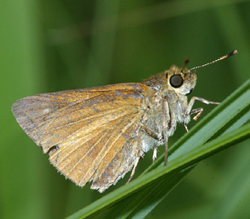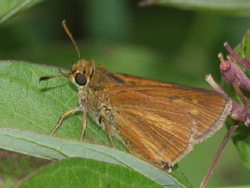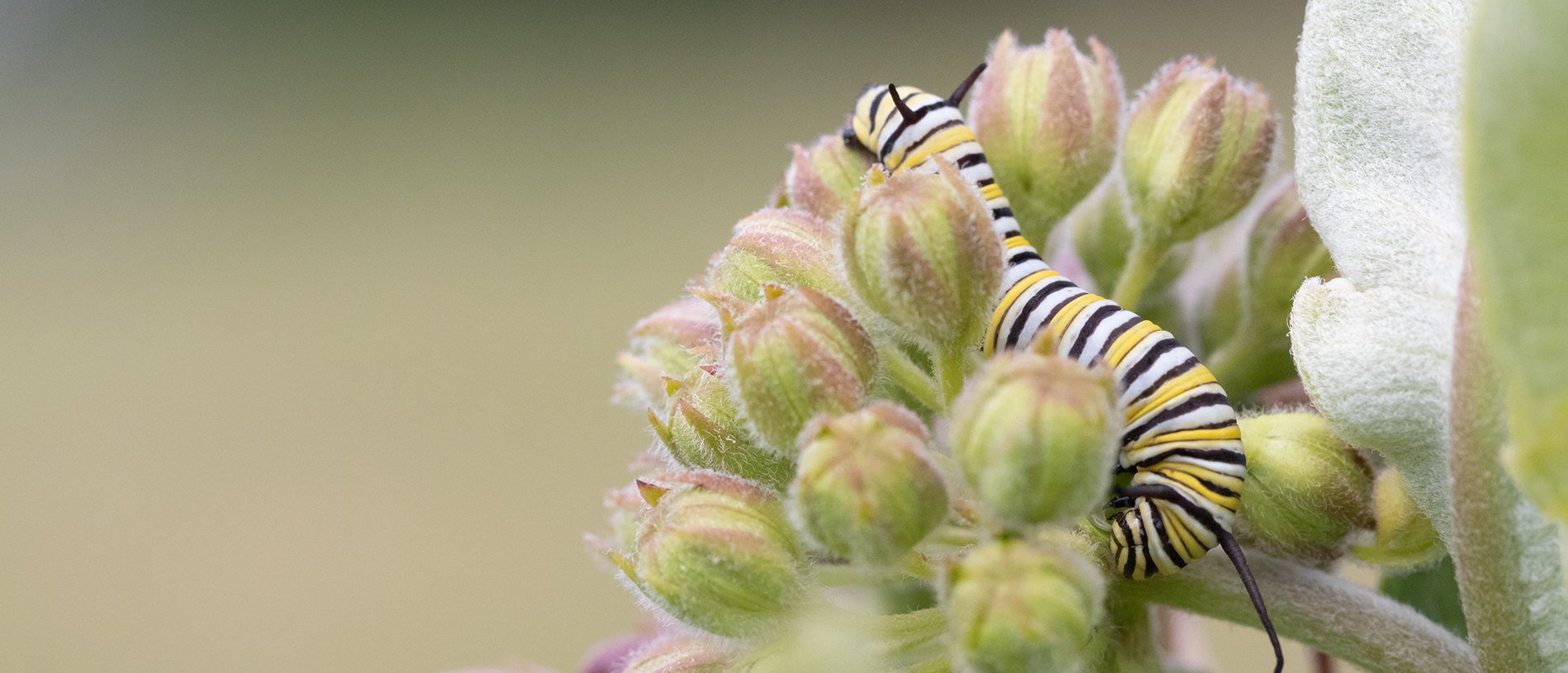Find a Butterfly
Dion Skipper
Euphyes dion
Named
Edwards, 1879

Identification
Wingspan 1 1/4 -1 5/8". A rather large wetland skipper, generally resembling its congener, the Black Dash (E. conspicua), which probably always flies with it in Massachusetts. The hindwings beneath have two diagnostic pale tawny rays running lengthwise along the veins, but no transverse spots such as those on E. conspicua. One of the rays is almost always prominent, while the other may be nearly lost. From the upper side, which is usually not visible in the field, the males probably cannot be separated on sight from Black Dash, but the tawny on the hindwings of the female is usually more extensive and the forewing spots more yellowish in Dion. Two-spotted Skipper (E. bimacula ) differs by its conspicuous white wing margin and lack of pale shades or spots on the hindwing beneath.
Distribution
The range is disjunct. Southeastern North Dakota east through extreme southeastern Ontario and western New York state to western New England. South to east Texas and eastward including much of Mississippi, Alabama, and Georgia through the Florida panhandle. Also along the Atlantic coastal plain. Absent in large portions of the Appalachian Region. In the Northeast known from Albany County, New York and Chittenden County, Vermont and southward in western Massachusetts and western Connecticut to Long Island and southeastern New York as well as northwestern and southern New Jersey.
Status in Massachusetts
Recorded in Massachusetts only recently as follows: 22 July 1962, near South Egremont (Berkshire Co.), G. Taylor (Yale University Collection). Two records during the Atlas period: 11 July 1986, Hancock (Berkshire Co.), R. Wendell and 17 July 1986, Stockbridge (Berkshire Co.), D. Schweitzer. In July of 1993 and 1994 D. Wagner reported 20+ and 30+ Dion Skippers at Stockbridge (Berkshire Co.). Dion Skipper is listed as Threatened under the Massachusetts Endangered Species Act.

Flight Period in Massachusetts
Probably most of July with possible late stragglers into early August. Extreme dates: 9 July 1994, Stockbridge (Berkshire Co.), D. Wagner and 17 July 1986, Stockbridge (Berkshire Co.), D. Schweitzer. One flight.
Larval Food Plants
Several large sedges of the genera Carex and Scirpus are reported elsewhere (Scott, 1987). Calcareous wetland populations are usually associated with Carex lacustris which is a known food plant in several states including New York (Shapiro, 1974). This may well be the only food plant used in New England.
Adult Food sources
Calcareous wetland populations often nectar at Swamp Milkweed and Buttonbush. In southern New Jersey, often leaves its breeding habitat to find nectar.

Habitat
Calcareous wetlands, including fens, sedge meadows and stream corridors are used in nearby states. A high quality fen in Massachusetts.
Life Cycle
EGG: Light green. OVIPOSITION: Eggs are laid on the food plant. LARVA: Yellowish-green with a black head and collar and yellow hairs. PUPATION: Occurs in silked leaf nest. OVERWINTERING STAGE: Third instar larva.
Larvae complete feeding in June and pupate, probably in the shelter. Emergence begins in early July. Adults are usually found on or very near the food plant except when nectaring. Males defend territories, usually a patch of the food plant, which are often near a good nectar source. Females fly among the sedges.
Notes
Western New England fens and associated calcareous wetlands are nearly unique among such habitats in eastern and central North America in their apparent near lack of any globally or regionally rare Lepidoptera. Some other fen clusters have endemic or near endemic taxa. Schweitzer and Goldstein found many to lack even expected species. Whether this depauperate fauna is natural or the result of past DDT spraying aimed at preventing the westward spread of the gypsy moth will never be known. If the latter, full faunal recovery may occur after the next glacial retreat, but is unlikely sooner. Such spraying might account for some absences of this species, which seems to be absent in most seemingly suitable habitats. Because it is a powerful flier and can occupy a variety of calcareous wetland habitats, this species probably is a fairly good short distance colonizer. It is, however, almost never numerous, so local extirpations may occur frequently. This account was contributed by Dr. Dale Schweitzer, Invertebrate Zoologist, Eastern Heritage Task Force/The Nature Conservancy.
This account was contributed by Dr. Dale Schweitzer; Invertebrate Zoologist, Eastern Heritage Task Force/The Nature Conservancy.



